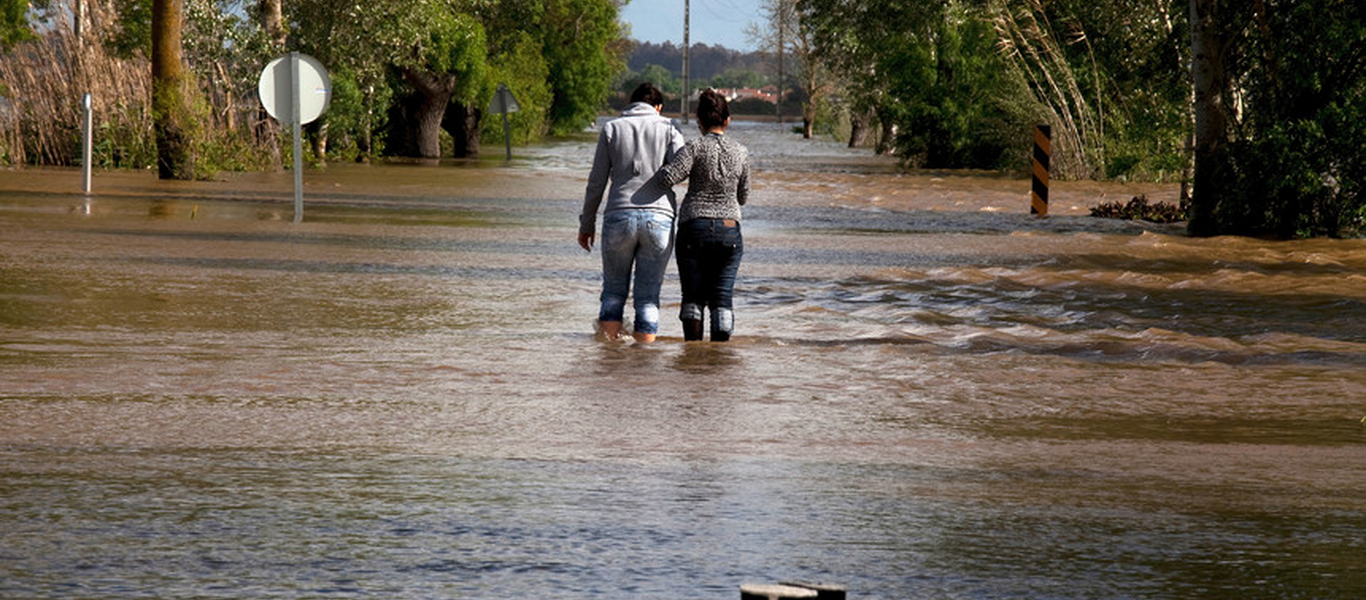Climate Change: we need 1.1 billion euros to fight the extreme events in Portugal (in Jornal Expresso)

Climate Change: we need 1.1 billion euros to fight the extreme events in Portugal (in Jornal Expresso)
The latest report from the Intergovernmental Panel on Climate Change (IPCC) confirms how “unambiguous” is the human hand behind the climate crisis and what the scenarios are in terms of global impacts depending on rising global temperatures. Extreme weather events, which include heavy rains that flood streets and houses at a glance, as well as bad weather, in addition with spring tides and the rise in mean sea level, accentuate coastal overtopping and loss of territory, or heat waves that increase in early mortality, among other phenomena, are knocking on our door. And will Portugal — which this week was under “orange” and “yellow” warnings in practically all districts — adapting at the right speed?
The latest report from the Intergovernmental Panel on Climate Change (IPCC) confirms how “unambiguous” is the human hand behind the climate crisis and what the scenarios are in terms of global impacts depending on rising global temperatures. Extreme weather events, which include heavy rains that flood streets and houses at a glance, as well as bad weather, in addition with spring tides and the rise in mean sea level, accentuate coastal overtopping and loss of territory, or heat waves that increase in early mortality, among other phenomena, are knocking on our door. And will Portugal — which this week was under “orange” and “yellow” warnings in practically all districts — adapting at the right speed?
Most of the specialists that Expresso spoke with said that the country has to speed up its pace. “The greater the delay in reducing greenhouse gas emissions, the more demanding the need for adaptation”, said Pedro Matos Soares, atmospheric physicist and researcher at the Dom Luiz Institute. “We are 10 years behind in mitigating greenhouse gases and, by extension, in adapting to climate change”, emphasizes Pedro Garrett, co-founder of the environment and climate change technology startup 2adapt, which allows around 40 adherent municipalities present projects that meet the 17 United Nations Sustainable Development Goals (SDGs), including adaptation to the climate crisis.
But he admits that many have not yet left the paper.
Lack of action
Portugal has a strategy and an action plan for adapting to climate change nationally and in regional and municipal plans, but few of those have a practical translation in the reorganization of the territory or in concrete actions to create greater resilience to the impacts of the climate crisis. With the exception of municipalities such as Loulé, Lisbon, Porto or Cascais — pioneers in good adaptation plans —, "the vast majority of municipalities show great illiteracy from a technical and political point of view, which hinders the population's literacy", says the geographer Ana Monteiro, researcher at the University of Porto. The coordinator of the Metropolitan Plan for Adaptation to Climate Change in the Metropolitan Area of Porto (AMP) is “perplexed” to see that “adaptation to climate risks is not an issue that enters local debates”, despite the susceptibility of the national territory.
The geographer António Lopes, coordinator of the research group ZHEPHYRUS, who worked on the Metropolitan Plan for Adaptation to Climate Change (AML), also recognizes that, despite “there are some excellent plans, there has not yet been time to implement them”. And he fears that, “at the local level and regional authorities, there is the notion that these plans are needed above all to access community funds” and then remain waiting. When observing the results in the 17 municipalities of the AMP, Ana Monteiro verifies that "only Porto and Vila Nova de Gaia are showing some effort, including climate risks in the Municipal Master Plan, and Porto presents afforestation plans considering the bioclimatic component". To explain: if the soil is made less impermeable and if trees and green spaces are used for greater infiltration of rain and ventilation, floods and heat waves are attenuated.
Lisbon and Loulé are also carrying out projects like these, to increase green spaces and restore water lines with natural-based solutions, in order to promote the retention and infiltration of rainwater, allowing better management of the water cycle and the regulation of comfort against temperature and humidity to mitigate the effects of heat waves. Loulé was, in fact, the first municipality at national level to complete the Adapt-Local adaptation strategy. The “concern about the municipality's fragilities and extreme events, such as bad weather, floods and droughts, made us act”, emphasizes the mayor of Loulé, Vítor Aleixo. “Based on scenarios projected up to 2100 by the team of Carlos Antunes [from the Faculty of Sciences of the University of Lisbon (FCUL), who has been working on coastal risk mapping associated with mean sea level rise], we were forced to review several projects”, he says. These include raising the share of the new municipal market and “negotiating with investors, such as those in the Vilamoura project, to reduce densities and include more green spaces”. Lisbon also imposed a threshold above 3.8 meters for new construction in areas at risk of flooding. But if it rained more than 0 mm in a single day, “it would cause flooding in several critical points in Lisbon, as happened in 2014”, admits the CML.
Lack of money
The Portuguese Environment Agency (APA) claims that “since 2010 Portugal has developed public policies to respond to the effects of climate change, promoting the territory's climate resilience and reducing its vulnerability”. Among these, it is highlighted the AdaPT Program and the Adaptation to Climate Change Action Programme (P-3AC), which “systematize measures related to fire prevention; soil conservation and improvement; sustainable use of water; ecosystem resilience; prevention of risks associated with heat waves; combating invasive species and diseases; flood protection and coastal protection; among others, and creates a reference for the preparation of financing instruments between 2021 and 2027”. P-3AC estimates point out that “public expenditure available for this type of actions” totals more than 1.1 billion euros (funds from POSEUR and PDR 2020).
The National Roadmap for Adaptation 2100 — Assessment of the Vulnerability of the Portuguese Territory to Climate Change in the 21st Century is also under preparation, a project (with funding of 1.3 million euro) to support public policy on adaptation to climate change. “The project will only be completed in 2023”, points out the scientific coordinator of the project, Pedro Matos Soares. “The project is focused on the most vulnerable sectors and will have macroeconomic models that allow evaluating the cost-benefit of interventions, without separating mitigation from adaptation”, he explains.
Between 2018 and 2020 alone, the Coastal Strip Monitoring Program (COSMO), coordinated by APA, verified maximum setbacks of up to 30 meters in some stretches of the low and sandy coast in the North and Center of the country. Millions of cubic meters have been injected into the extension of beaches, dunes and underwater beds in several beaches in the country and will continue to be injected. “But these artificial sand fillings only work if they are well managed”, defends the geologist Paulo Baptista, from the University of Aveiro.
Actions and investments in Lisbon: In the last 12 years, the municipality has invested around €40 million in the expansion and modernization of its green structure and has €185 million to implement the General Drainage Plan, whose work is about to start and it will last about four years.
The objective is to face torrential rains and heat waves.
Porto: The Asprela Central Park project (with na area of 6 ha) is under construction, which involves a cost of €1.7 million and it is expected to contain 10,000 m3 of rainwater and reduce the risk of flooding in the metro network.
Madeira: To adapt to the increased risk of alluvium, the Regional Government installed a meteorological radar in Porto Santo and proceeded with the stabilization of slopes and reforestation of the headwaters of the streams and the construction of solid cargo containment in the main streams that cross the rivers. The urban centres: In 2010, torrential rains swept the south coast of the island, leaving 51 dead, 0 homeless and €1,000 million in damage.
Azores: The process of acquiring two state-of-the-art meteorological radars is in progress, to be placed by IPMA, by 2023, on the islands of Flores and São Miguel. The new radars make it possible to monitor bad weather or hurricanes, which are increasing its frequency in the North Atlantic. In 2019, hurricane “Lorenzo” left a trail of damage in the archipelago, which, according to the Regional Government, amounted to €330 million.
Insurance: The Portuguese Association of Insurers indicates that, “as a rule”, insurers do not cover situations where “a risk becomes an almost certain occurrence”. Houses in areas mapped as having a high probability of being affected by floods or sea level rise do not have coverage for these risks.
Source:
Jornal Expresso
(Carla Tomás, Tiago Miranda)
17/09/2021 14:06h
